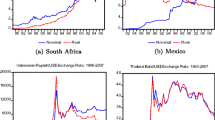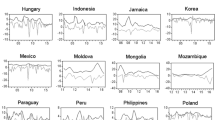Abstract
The insulating properties of flexible exchange rates have long been a highly contentious issue in emerging markets—not least in Asian emerging markets. A number of recent theoretical and empirical studies question whether a trade-off exists between rigid exchange rate regimes and insulation from foreign shocks when the degree of international capital mobility is high. On the other hand, Obstfeld et al. (2017) find that countries with flexible exchange rate regimes experience less real and financial instability in the face of global financial volatility. We contribute to this empirical debate by significantly extending their analysis. Overall, our findings are broadly consistent with their results, suggesting that flexible exchange rate regimes are better at insulating emerging markets from external shocks. There are, however, a few subtle differences. In particular, we find somewhat less robust evidence that limited flexibility is enough to insulate emerging markets from shocks.

Similar content being viewed by others
Notes
Most nonproprietary data are from Obstfeld et al. (2017), and we greatly appreciate the authors sharing their data and program.
Regression results available on request.
Although the absence of an effect may also reflect the endogeneity of the Federal Reserve’s policy for other US economic conditions that work in an offsetting direction.
For the International Monetary Fund’s classification of exchange rate regimes and monetary policy frameworks, see https://www.imf.org/external/np/mfd/er/2006/eng/0706.htm.
Regressions available from the authors on request.
For example, Cushman and De Vita (2017) examine whether fixed exchange rates encourage more inward foreign direct investment by using propensity-score matching methods.
Additional results for other specifications available on request.
In Table 14, we do not report the results in column (4) because the real shadow funds rate is also included as a regressor. While the federal funds rate used as a proxy for a global shock is nominal, the correlation between them is high, which makes the regression results unreliable.
Again, we do not report the results in column (4) as the real shadow funds rate is also included as a regressor.
References
Accominotti O, Eichengreen B (2016) The mother of all sudden stops: capital flows and reversals, in Europe, 1919–32. Econ Hist Rev 69(2):469–492
ADB (2018) Asian Development Outlook 2018 Update: Maintaining Stability amid Heightened Uncertainty, Asian Development Bank
Aizenman, Joshua, Menzie Chinn, and Hiro Ito. 2015. Monetary policy spillovers and the Trilemma in the new Normal: periphery country sensitivity to Core country conditions. NBER Working Paper. No. 21128. Cambridge, MA: National Bureau of economic research
Baker SR, Bloom N, Davis SJ (2016) Measuring economic policy uncertainty. Q J Econ 131(4):1593–1636
Baxter M, Stockman A (1989) Business cycles and the exchange-rate regime: some international evidence. J Monet Econ 23(3):377–400
Bekaert, Geert, and Arnaud Mehl. 2017. On the global financial market integration “swoosh” and the Trilemma. NBER Working Paper. No. 23124. Cambridge, MA: National Bureau of economic research
Bluedorn J, Bowdler C (2010) The empirics of international monetary transmission: identification and the impossible trinity. J Money Credit Bank 42(4):679–713
Caceres C, Carriere-swallow Y, Gruss B (2016) Global financial conditions and monetary policy autonomy. In: IMF Working Paper. WP/16/108. International Monetary Fund, Washington, DC
Choudhri E, Kochin L (1980) The exchange rate and the international transmission of business cycle disturbances: some evidence from the great depression. J Money Credit Bank 12(4):565–574
Cuba-Borda P, Mechanik A, Raffo A (2018) Monitoring the world economy: a global condition index. In: International finance discussion paper notes. Federal Reserve Board of Governors, Washington, DC
Cushman D, De Vita G (2017) Exchange rate regimes and FDI in developing countries: a propensity score matching approach. J Int Money Financ 77(C):143–163
Edwards S (2015) Monetary policy Independence under flexible exchange rates: an illusion? World Econ 38(5):773–787
Eichengreen B (1992) The comparative performance of fixed and flexible exchange rate regimes: interwar evidence. In: Thygesen N, Velupillai K, Zambelli S (eds) Business cycles, theories, evidence and analysis. St. Martin’s Press, New York, pp 229–272
Eichengreen, Barry. 1994. International monetary arrangements for the 21st century. Washington, DC: Brookings Institution
Eichengreen, Barry. 1999. Toward a new international financial architecture: a practical post-Asia agenda. Washington, DC: Institute of International Economics
Eichengreen B, Sachs J (1985) Exchange rates and economic recovery in the 1930s. J Econ Hist 85(December)
Federico P, Vegh C, Vuletin G (2014) Reserve requirements over the business cycle. In: NBER Working Paper. No. 20612. National Bureau of economic research, Cambridge
Fischer S (2001) Exchange rate regimes: is the bipolar view correct? J Econ Perspect 15(2):3–24
Frankel J, Schmukler S, Serven L (2004) Global transmission of interest rates: monetary Independence and currency regime. J Int Money Financ 23(95):701–733
Georgiadis G, Arnaud M (2015) Trilemma, not dilemma: financial globalization and monetary policy effectiveness. In: Globalization and Monetary Policy Institute Working Paper. No. 222. Federal Reserve Bank of Dallas, Dallas
Ghosh A, Ostry J, Qureshi M (2015) Exchange Rate Management and Crisis Susceptibility: A Reassessment. IMF Economic Review 63:238–276
Gopinath G (2017a) The international Price system. In: Proceedings of the Jackson Hole Symposium. Federal Reserve Bank of Kansas City, Kansas City
Gopinath G (2017b) Rethinking international macroeconomic policy. In: Unpublished. Harvard University, Cambridge
Londono, Juan, and Beth Anne Wilson. 2018. Understanding global volatility. IFDP note. Washington, DC: Federal Reserve System
Miniane J, Rogers J (2007) Capital controls and the international transmission of US monetary shocks. J Money Credit Bank 39(5):1003–1035
Mundell R (1963) Capital mobility and stabilization policy under fixed and flexible exchange rates. Canadian Journal of Economics and Political Science 29(4):475–485
Obstfeld, Maurice, Jonathan Ostry, and Mahvash Qureshi. 2017. A tie that binds: revisiting the Trilemma in emerging market economies. IMF Working Paper. WP/17/130. Washington, DC: International Monetary Fund
Philippon T, Zettelmeyer J, Borensztein E (2001) Monetary Independence in emerging markets: does the exchange rate regime make a difference. In: IMF Working Paper. WP/10/11. International Monetary Fund, Washington, DC
Potines V, Rajan R (2011) Foreign exchange market intervention and reserve accumulation in emerging Asia: is there evidence of fear of appreciation? Econ. Lett. 111:252–255
Quinn D, Toyoda M (2008) Does capital account liberalization Lead to economic growth? Rev Financ Stud 21(3):1403–1449
Reinhart C, Rogoff K (2004) The modern history of exchange rate arrangements: a reinterpretation. Q. J. Econ. 199:1–48
Rey H (2015) Dilemma not Trilemma: the global financial cycle and monetary policy Independence. In: NBER Working Paper. No. 21162. National Bureau of economic research, Cambridge
Rey H (2016) International channels of transmission of monetary policy and the Mundellian Trilemma. IMF Economic Review 6:6–35
Ricci L, Shi W (2016) Trilemma or dilemma: inspecting the heterogeneous response of local currency interest rates to foreign rates. In: IMF Working Paper. No. WP/16/75. International Monetary Fund, Washington, DC
Shambaugh J (2004) The effect of fixed exchange rates on monetary policy. Q J Econ 119(1):301–352
Shin, Hyun. 2016. The Bank/capital markets Nexus Goes global. Speech made at the London School of Economics and Political Science, Nov. 15. http://www.bis.org/speeches/sp161115.pdf
Tovar, Camilo. 2004. Devaluations, output and the balance sheet effect: a structural econometric analysis. Unpublished. Basel: Bank for International Settlements
Wu JC, Xia FD (2016) Measuring the macroeconomic impact of monetary policy at the zero lower bound. J Money Credit Bank 48(2–3):253–91, 253
Yasuba Y (1988) The Japanese economic and economic policy in the 1930s. In: Butlin N, Gregory R (eds) Recovery from the great depression. Cambridge University Press, Cambridge, pp 136–151
Acknowledgements
This paper was prepared as background material for the Asian Development Outlook 2018 Update: Maintaining Stability amid Heightened Uncertainty. For comments we thank Ila Patnaik and other workshop participants in the Asian Development Outlook Update Mid-Term Workshop. We also thank Dohoon Kim for excellent research assistance; the Asian Development Bank for financial support; and Mahvash S. Qureshi, Beth Anne Wilson, and Andrea Raffo for help with data. Kwanho Shin acknowledges support by a Korea University Grant (K2009011). Barry Eichengreen thanks the Clausen Center of the University of California, Berkeley.
Author information
Authors and Affiliations
Corresponding author
Ethics declarations
Disclaimer
The views expressed in the paper are those of the authors and do not necessarily reflect the views and policies of the Asian Development Bank.
Additional information
Publisher’s Note
Springer Nature remains neutral with regard to jurisdictional claims in published maps and institutional affiliations.
Appendices
Appendix
Blurb
This paper empirically reexamines the contentious issue of whether flexible exchange rates can insulate emerging markets from external shocks. The results are broadly consistent with the insulating properties of flexible exchange rate systems. But they are somewhat less supportive of the notion that even intermediate exchange rate regimes with limited flexibility can help cushion the effect of global volatility.
100-World Blurb
Whether or not flexible exchange rates can protect emerging markets from external shocks has long been a highly contentious issue in international economics. A number of recent theoretical and empirical studies cast doubt on the shock-mitigating benefits of exchange rate flexibility. On the other hand, a 2017 paper by Maurice Obstfeld, Jonathan Ostry, and Mahvash Qureshi finds that flexible exchange rates promote output and financial stability in the face of global shocks. The authors of this paper join the debate by significantly extending and performing sensitivity checks on the 2017 paper. Overall, their findings confirm that flexible exchange rate regimes are better at insulating emerging markets from external shocks.
Rights and permissions
About this article
Cite this article
Eichengreen, B., Park, D., Ramayandi, A. et al. Exchange Rates and Insulation in Emerging Markets. Open Econ Rev 31, 565–618 (2020). https://doi.org/10.1007/s11079-020-09587-2
Published:
Issue Date:
DOI: https://doi.org/10.1007/s11079-020-09587-2




